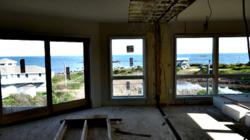
Westport, MA (PRWEB) June 18, 2012
During hurricane season, vacation homes along the shore can take a terrible beating from wind and waves. In recent years, the government agency FEMA has determined how we must engineer our homes in each area of the country to ensure quality standards. FEMA has also divided the U.S. shore regions into zones that include especially stringent requirements for home construction. FEMA regulations always supersede local zoning.
But one particular new home, whose construction was initiated this spring, is in whats called the North Zone, the worst wind zone in the Northeast. This area blankets the entire lower arm of Cape Cod because storms here can be very severe with wind loads of 120mph, or more. The Perfect Storm is a perfect example, but not the only example of the battering these stretches of beach have endured. The law requires that structural framing of shore house in this zone must be engineered to resist winds of this magnitude. The owner of this particular property, a doctor with a family including several young children, chose to go with a Modular Architect just to be sure his home was as strong as possible. Modular designs are thought to be stronger than traditionally built homes because modular construction has redundancy in the framing where the sections fit together. One of these fits is called the marriage wall, which is a sheer wall that inherently resists sideways forces of wind.
The chosen architect, Douglas Cutler A.I.A., founder of Modular Architecture in Wilton, CT, also engineered and designed this vacation home with impact resistant windows to keep the residents safe from shattering glass in the event that they were unable to evacuate before a storm. If the home is, hopefully, unoccupied, these windows will also protect the furnishings from wind and water damage.
Waves and Flooding
The government, in an effort to gain support for the new construction rules, has studied paths of hurricanes and determined minimum floor levels above high tide lines. They also determined how strong foundations must be in order resist wave action. When the doctor of the Cape Cod Modular decided to replace the existing bungalow on his property, the replacement floor had to be built 10 feet higher than the previous floor. The higher the floor, the less waves can chew away at it.
The foundation, too, is literally a pillar of strength. Douglas Cutler designed a series of 18 concrete piers, each one 12 feet high that come vertically out of the ground. The pillars are about 18 inches square, poured with 500 lb. reinforced concrete and adhered to the grade beam horizontal which lies 3.6 feet below the finished grade. The home is then placed above these pillars. This is code for the pillar depth and height in this area and even though there may be local regulations limiting the height of home. Once again, FEMA regulations always supersede local zoning for safety purposes.
Calm Weather Advantages of Modular
The doctors family wanted a vacation home with spectacular views. Douglas Cutler designed them a modular home that turns tradition on its head sleeping rooms on the bottom, living area on the top so that the family can take advantage of the breathtaking views from about 30 feet off the ground. On a clear day they will be able to see Marthas Vineyard and Cuttyhunk.
This Cape Cod home, set earlier this Spring, should be completed by midsummer 2012 right in time for hurricane season. The furniture will be moved in and the lobsters will be served, dripping with butter on one of the beautiful decks. There are carports beneath the piers, 4 bedrooms with 3 baths, decks and an open floor plan on the top. The lot is small, 1/4 acre or less which makes it ideal for building a modular home.
The differences between building a modular home and traditional stick-built construction can be confusing, but just remember that custom modular is simply a hybrid form of construction, says Douglas Cutler. The foundation is built conventionally but the rest is built in a factory except for the detailing In order to meet code and get the safest home available, designed to resist the main natural forces that exist, the architect must always lead in the planning. When is comes to strength, beauty and the latest amenities, home buyers and builders will have a super advantage if they call their modular architect first.
Learn more about Douglas Cutler Architects and their award winning modular designs at http://www.modulararchitecture.com
